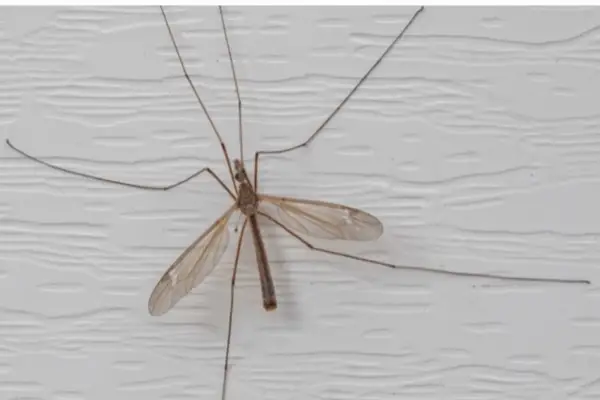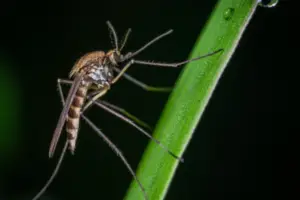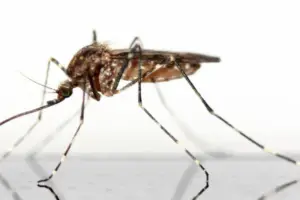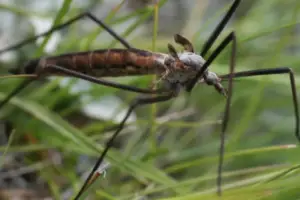Lately, you may have seen some large, leggy insects bumbling around your home, bouncing off walls and ceilings. But what are these creatures?
While many people call them “mosquito eaters” or “mosquito hawks,” they are actually crane flies. And unfortunately, they do not eat mosquitoes.
Many reports claim that they bite or sting, and this is also false. The adults are harmless, and many species don’t even have mouthparts to feed at all!
However, their larvae can be pests on lawns and turfgrass.
Understanding Mousquito Eaters (AKA Crane Flies)
The larvae can grow up to 1-1/2 inches long, with a brown, wormlike appearance and very tough skin.
They may resemble white grubs, but crane fly larvae do not have legs. The majority of lawn damage from crane flies is seen along the Pacific Northwest coast.
In California, damage has been found mostly in Humboldt and Del Norte counties, rarely in warmer, dryer inland areas of the state. Although wet springs and waterlogged soils are usually associated with higher populations of crane flies.
Do Mosquito Eaters Eat Mosquitoes
Mosquito eaters are not direct predators of adult mosquitoes. However, during their larval stage, they do consume mosquito larvae, but only sporadically. Their primary source of sustenance, though, comes from feeding on flower nectar.
Related Post: Mosquito Shocker Plant, Annual Or Perennial
How to Prevent Mosquito Eater Infestations
You can prevent crane flies from infesting your lawn by properly irrigating and fertilizing it. Adjust irrigation systems during rainy periods to avoid overwatering.
Remove excess thatch and aerate your lawn to improve drainage. Reduce shady areas by pruning back tree branches to allow more light to reach the grass in the early morning and late afternoon.
8 Essential Facts About Mosquito Eaters
The encountered insects, resembling mosquitoes with elongated bodies and legs, are often mistaken for the dangerous mosquito species, but they are not mosquitoes at all.
These insects are commonly known as mosquito eaters, although the name is deceptive.
Here are eight essential facts about these intriguing creatures:
Fact 1: Daddy Long Legs
Often referred to as “daddy long legs,” these insects are not the typical cellar spiders; they are, in fact, crane flies.
Fact 2: A Misleading Moniker
Contrary to their name, they don’t primarily feast on mosquitoes. While they do consume mosquito larvae occasionally during their larval stage, their main source of sustenance is flower nectar.
Fact 3: A Harmless Presence
Despite being larger than mosquitoes, they lack the ability to prey on these bloodsucking insects.
Fact 4: The Annoying Buzz
Though harmless to humans, their presence can be bothersome due to the buzzing sound created by their wings.
Fact 5: Distinguishing the Crane Flies
The two common types of crane flies found in homes and gardens are the European crane fly and the common crane fly, which share a striking resemblance except for their differing number of life cycles per year.
Fact 6: Prolific Breeders
Known for rapid multiplication, these long-legged flies often hover around outdoor lighting fixtures in warm weather.
Fact 7: Unwelcome Garden Guests
Regrettably, they are considered pests as they inflict damage on plants. Residing in the upper layers of soil, they feed on plant roots and emerging leaves, hindering the full growth potential of your turf and plants.
Fact 8: Nature’s Balance
If your garden fosters a healthy ecosystem with other beneficial insects, birds, and small wildlife, such as raccoons and skunks, they can naturally regulate the mosquito population.
Managing the Mosquito Eater Dilemma
Should you find yourself overwhelmed by an abundance of these flies, seeking assistance from a reputable Modesto pest control company is the best course of action.
Professional intervention ensures efficient management without harming beneficial garden inhabitants by utilizing appropriate methods and products tailored to the situation at hand.
Mosquito Eater and Other Mosquito Imposters
Could this be a colossal mosquito, ready to strike? Here are some common urban insects that often deceive people:
Mosquito Eater
- Name: Crane Flies, AKA Mosquito Eaters
- Size: Exceeding a quarter’s size and stretching at least 2 inches long
With their long legs, these insects can send shivers down the spines of the unsuspecting, who mistake them for bloodsucking mosquitoes.
However, the truth is, these are not mosquitoes at all. Often dubbed “mosquito eaters” or “mosquito hawks,” crane flies lack any biting mouthparts upon microscopic examination!
They are entirely non-threatening and sustain themselves on nectar alone.
Crane flies are actually an indicator of a flourishing ecosystem. Typically, they emerge from the soil after a rain event, coinciding with warm weather.
So, the next time you encounter a crane fly, gently guide it outdoors. Reserve those crushing blows for the genuine menace: mosquitoes.
Midges
- Name: Midges
- Size: 1/4 inch—approximately the same size as most adult mosquitoes.
Swarming is uncommon among city mosquitoes. If you observe small insects swarming, they are probably midges.
Midges belong to the Chironomidae family, which falls under the Diptera order (true flies).
Swarmers, not biters: This tiny insect is often mistaken for mosquitoes but doesn’t engage in biting. Warm summer evenings often witness them hovering in swarms.
Unlike local urban mosquitoes, they don’t form such swarms. Thankfully, midges don’t pose health risks, though they can be quite bothersome.
Related Post: Mosquito Hawks, Crane Flies, Skeeter Eater: The Myths
Different Between Midges and Mosquitoes
One of the main distinctions between midges and mosquitoes lies in their mouthparts. While mosquitoes possess a piercing proboscis to draw blood from animals, midges have short, non-piercing mouthparts and exclusively consume nectar or plant fluids.
In most cities and states in the U.S., extensive control measures are only required when adult midge populations become unusually high.
These insects typically breed in flowing waters and prefer the shallow, nutrient-rich environments often found in storm drain systems.
How to control Midges
Since midges share significant physiological and genetic similarities with mosquitoes, the larvicidal agents employed for mosquito control (insect growth regulators) are also effective in managing midge populations.





